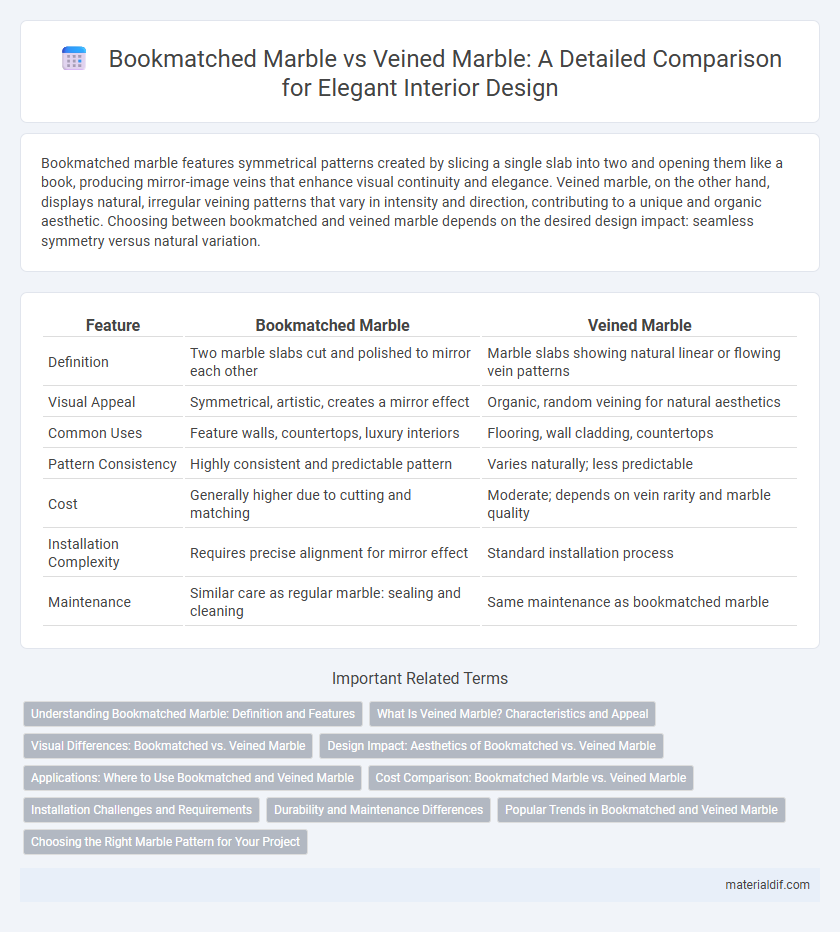Bookmatched marble features symmetrical patterns created by slicing a single slab into two and opening them like a book, producing mirror-image veins that enhance visual continuity and elegance. Veined marble, on the other hand, displays natural, irregular veining patterns that vary in intensity and direction, contributing to a unique and organic aesthetic. Choosing between bookmatched and veined marble depends on the desired design impact: seamless symmetry versus natural variation.
Table of Comparison
| Feature | Bookmatched Marble | Veined Marble |
|---|---|---|
| Definition | Two marble slabs cut and polished to mirror each other | Marble slabs showing natural linear or flowing vein patterns |
| Visual Appeal | Symmetrical, artistic, creates a mirror effect | Organic, random veining for natural aesthetics |
| Common Uses | Feature walls, countertops, luxury interiors | Flooring, wall cladding, countertops |
| Pattern Consistency | Highly consistent and predictable pattern | Varies naturally; less predictable |
| Cost | Generally higher due to cutting and matching | Moderate; depends on vein rarity and marble quality |
| Installation Complexity | Requires precise alignment for mirror effect | Standard installation process |
| Maintenance | Similar care as regular marble: sealing and cleaning | Same maintenance as bookmatched marble |
Understanding Bookmatched Marble: Definition and Features
Bookmatched marble is created by slicing a single stone slab into two adjacent pieces, producing mirror-image patterns that align seamlessly when placed side-by-side. This technique highlights symmetrical veining and enhances visual continuity, making it a popular choice for sophisticated architectural and interior designs. Unlike veined marble, which showcases naturally occurring lines and streaks without symmetry, bookmatched marble emphasizes precise pattern repetition, adding a distinctive artistic element to surfaces.
What Is Veined Marble? Characteristics and Appeal
Veined marble features natural linear patterns created by mineral deposits, resulting in distinctive, flowing lines that enhance its elegance and visual appeal. Its unique characteristics include varied color contrasts within the veins, which add depth and sophistication to surfaces, making it a popular choice for luxury interiors. The appeal of veined marble lies in its dynamic, organic patterns that provide a timeless aesthetic, perfect for statement flooring, countertops, and wall cladding.
Visual Differences: Bookmatched vs. Veined Marble
Bookmatched marble features symmetrical patterns created by slicing a single slab into consecutive sheets and placing them side by side, creating a mirror image effect that enhances visual continuity. Veined marble displays natural, irregular veining that varies across slabs, resulting in unique, organic patterns with no symmetrical repetition. The distinct visual hallmark of bookmatched marble lies in its precise, mirrored symmetry, contrasting with the unpredictable and flowing appearance of veined marble.
Design Impact: Aesthetics of Bookmatched vs. Veined Marble
Bookmatched marble creates a striking symmetrical pattern by pairing two adjoining slabs, enhancing spaces with bold, mirror-like visuals that demand attention. Veined marble, characterized by its natural flowing lines and irregular patterns, offers a more organic, continuous aesthetic that complements diverse interior styles. The choice between bookmatched and veined marble significantly influences design impact, where bookmatched marble serves as a dramatic focal point, while veined marble provides subtle sophistication and timeless elegance.
Applications: Where to Use Bookmatched and Veined Marble
Bookmatched marble is ideal for statement walls, fireplace surrounds, and large tabletops where symmetrical patterns create a dramatic visual impact. Veined marble suits flooring, kitchen countertops, and bathroom vanities, offering organic, flowing lines that enhance natural elegance. Both types excel in luxurious interior designs, but bookmatched marble stands out in spaces requiring focal points, while veined marble provides versatile surface applications.
Cost Comparison: Bookmatched Marble vs. Veined Marble
Bookmatched marble typically costs 20-40% more than veined marble due to the labor-intensive process of aligning and matching slabs for a perfect mirror image. Veined marble, with its natural, less precise patterns, generally offers a more budget-friendly option without sacrificing aesthetic appeal. Selecting between the two often depends on project scale and desired visual impact versus budget constraints.
Installation Challenges and Requirements
Bookmatched marble requires precise alignment during installation to ensure the mirror-like patterns seamlessly continue across adjacent slabs, demanding meticulous planning and skilled labor. Veined marble installation focuses on matching the flow of veins but allows for more flexibility in slab positioning, reducing the complexity of pattern alignment. Both types necessitate thorough surface preparation and strict adherence to environmental conditions to prevent damage and maintain the stone's natural aesthetic.
Durability and Maintenance Differences
Bookmatched marble offers a seamless, symmetrical pattern by pairing two slabs, creating a visually striking effect while maintaining standard marble durability that requires regular sealing to prevent stains and etching. Veined marble features natural, irregular veins with similar hardness and porosity to bookmatched marble, demanding consistent maintenance such as cleaning with pH-neutral products to preserve its surface. Both types of marble are prone to scratches and chemical damage, necessitating careful upkeep but do not significantly differ in durability or maintenance requirements.
Popular Trends in Bookmatched and Veined Marble
Bookmatched marble features symmetrical patterns created by pairing slabs, increasingly popular in luxury interiors for its dramatic and artistic appeal. Veined marble, prized for its natural, flowing lines, remains a timeless choice in modern and classic design schemes due to its organic aesthetics. Recent trends highlight a surge in demand for bold, contrasting veins in both bookmatched and veined marble, enhancing visual impact in statement walls and flooring.
Choosing the Right Marble Pattern for Your Project
Bookmatched marble offers a striking, mirrored pattern that creates a symmetrical, visually dynamic effect ideal for feature walls and large surfaces. Veined marble showcases natural linear or swirling patterns emphasizing fluidity and organic movement, perfect for sophisticated yet subtle elegance in countertops or flooring. Selecting between bookmatched and veined marble depends on your design goal--opt for bookmatched marble to make a dramatic architectural statement and veined marble for timeless versatility and natural charm.
Bookmatched Marble vs Veined Marble Infographic

 materialdif.com
materialdif.com